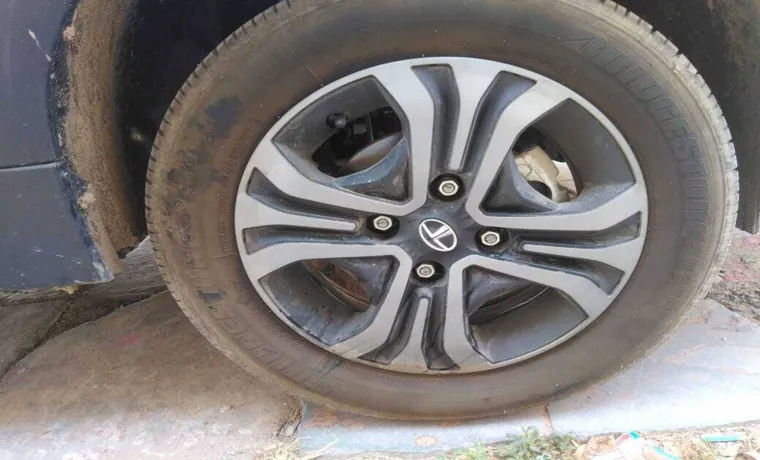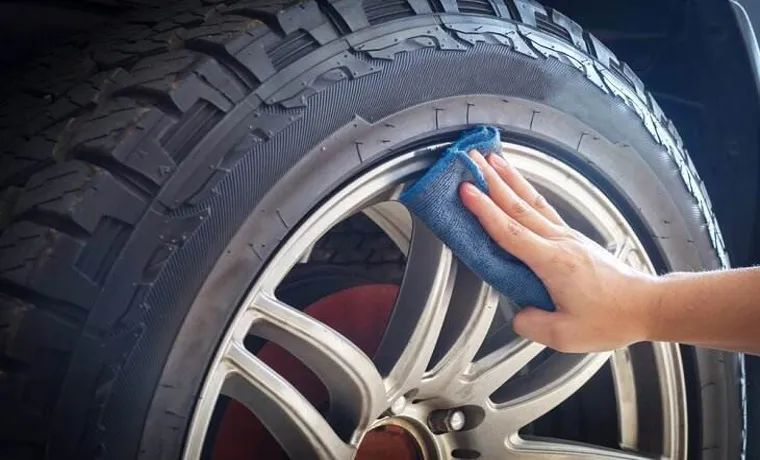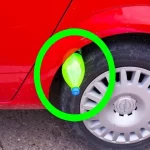Tire blooming is a tire surface phenomenon that every car owner dreads. This condition occurs when the tire’s surface turns brown instead of black and appears as a white dust that accumulates on the rims. Tire blooming occurs when the rubber’s non-volatile components evaporate and oxidize, creating a dry, powdery residue.
Aside from its unsightly appearance, blooming can damage your tires, decreasing their lifespan and making them more susceptible to punctures. The good news is that tire blooming can be prevented with proper care and maintenance. Regular cleaning with mild detergent and water can help remove debris and prevent contamination that can lead to blooming.
Avoid using tire dressings with high silicone content that can trap dirt and accelerate blooming. Additionally, storing tires in a cool, dry place away from sunlight and chemicals can prevent blooming and extend their life. Before you despair and think that your tires are doomed to bloom, remember that prevention is key.
With the right knowledge and maintenance routine, you can keep your tires looking and performing their best. In this blog, we’ll explore tire blooming in more detail, the causes, and preventative measures to keep your tires looking pristine.
Table of Contents
Understanding Tire Blooming
Tire blooming is a phenomenon that occurs when the chemical components of rubber interact with oxygen, causing the rubber to discolor and turn brown. This is a common occurrence in tires that are stored for long periods of time or not used regularly. Blooming is not harmful to the tire’s performance, and it can easily be remedied by wiping the affected area with a clean cloth or using a tire shine product.
However, it is important to note that blooming can be a sign of tire degradation, and if it is accompanied by cracking or blistering, it may be time to replace the tire. Regular use and proper storage can help prevent tire blooming and ensure the longevity of your tires.
Definition of Tire Blooming
Tire blooming refers to the discoloration or browning of a tire’s sidewall due to exposure to UV radiation. It mainly affects tires made of natural rubber, which tends to harden and crack with age, causing the protective chemicals to evaporate and the oil to seep out of the rubber. Tire blooming is typically more prevalent in hotter climates, and it is a sign that the tire is losing its protective barrier and is becoming more prone to cracking.
While tire blooming doesn’t typically affect the tire’s performance, it can be visually unappealing, and it may indicate that you need to take better care of your tires. To prevent tire blooming from occurring, store your vehicle in a cool, dry, and shaded spot when possible, and use tire dressings that contain UV protectants to protect the tires’ sidewalls from the sun’s harmful rays.

Causes of Tire Blooming
Tire blooming is a phenomenon that occurs when the rubber in a tire begins to degrade and oxidize due to environmental factors such as heat, humidity, and UV exposure. This oxidation causes the tire to turn brown or orange, hence the term “blooming.” It is important to understand that blooming is not a sign of tire damage or a safety issue, but rather a cosmetic one.
Nevertheless, it can be frustrating for vehicle owners who want their tires to maintain a uniform appearance. To prevent blooming, it is recommended to store tires in a cool, dry place away from direct sunlight. Regular cleaning and conditioning of the tires can also help to slow down the oxidizing process.
Overall, understanding the causes of tire blooming can help vehicle owners take proactive steps to maintain the appearance and longevity of their tires.
Effect of Tire Blooming on Tires
Tire blooming is a phenomenon that occurs when the components of a tire react to environmental factors, such as heat or humidity, causing the rubber to expand and create a white film on the tire’s surface. This may occur during prolonged storage or when a tire is not frequently used. While tire blooming may not affect the tire’s performance, it can be unsightly and cause concern for those not familiar with the process.
Blooming can also be an indication of the tire’s age, as older tires are more susceptible to the phenomenon. However, tire manufacturers often recommend against the use of chemicals to remove the white film, as it may damage the tire’s surface or compromise its structural integrity. Therefore, it’s best to leave the blooming alone and focus on proper tire maintenance to prolong the life of your tires.
Preventing Tire Blooming
Tire blooming is a phenomenon that occurs when tires start turning yellow and brown, losing their original color and becoming unsightly. This happens when a tire’s protective oils and waxes evaporate due to exposure to sunlight, oxygen, and other environmental factors. The ultraviolet radiation from the sun causes the rubber to break down and release its natural oils and waxes, leaving behind a layer of white powder on the surface known as bloom.
Preventing tire blooming is essential for maintaining the aesthetics and longevity of your tires, and there are several ways to do so. Using tire covers when parking your vehicle for extended periods, protecting your tires from direct sunlight, and using tire coatings or conditioners are some of the most effective methods to prevent tire blooming and keep your tires looking as good as new.
Routine Tire Maintenance
Routine Tire Maintenance: Preventing Tire Blooming Are you familiar with the term “tire blooming?” This refers to the unsightly brown haze that often appears on the tires of parked cars. It’s caused by the oxygen in the air reacting with the rubber chemicals in the tire, resulting in a discolored surface. Preventing tire blooming isn’t just about maintaining the appearance of your vehicle – it’s an important tire maintenance measure that can extend the life of your tires.
So, how can you prevent tire blooming? Firstly, make sure that your tire pressure is maintained at the correct level. A tire that is underinflated can cause more of the tire surface to come into contact with the ground, increasing the oxygen exposure and promoting blooming. Additionally, avoid parking your car for long periods in direct sunlight or near sources of heat – such as bonfires or grills – as this can also encourage blooming.
Regular tire cleaning is also an important prevention measure. Use a mild soap and warm water to gently clean the tires, avoiding harsh chemicals or abrasive tools that can damage the rubber. This can remove dirt and other debris that can encourage blooming.
In conclusion, preventing tire blooming is an important part of routine tire maintenance. By ensuring that your tires are properly inflated, avoiding excessive time in direct sunlight or near sources of heat and regularly cleaning your tires, you can keep them looking great and performing at their best for years to come.
Proper Storage of Tires
Proper Storage of Tires: Preventing Tire Blooming Proper storage of tires is important to keep them in good condition and prevent tire blooming. Tire blooming is a phenomenon that occurs when tires are exposed to moisture and sunlight, causing the rubber to deteriorate and turn white. To prevent this from happening, it is important to store tires in a cool, dry place away from sunlight and moisture.
It is also recommended to stack the tires in an upright position and rotate them every three months to prevent flat spots. Tire covers can also be used to further protect the tires from the elements. By taking the necessary precautions, you can ensure that your tires remain in good condition and avoid the unsightly and potentially dangerous effects of tire blooming.
Choosing the Right Tire Cleaner
When it comes to keeping your car tires clean, choosing the right tire cleaner is crucial. Not only does it help maintain the appearance of your tires, but it can also prevent tire blooming. This occurs when a tire’s surface begins to turn brown due to an accumulation of dirt and grime, which can damage the tire’s surface and reduce its lifespan.
The best tire cleaners will effectively remove dirt and debris without causing any harm to the tire rubber. Look for cleaners that are specifically designed for tires and avoid using harsh chemicals that may cause discoloration or dry out the rubber. Natural cleaners such as vinegar and baking soda can also be effective, but make sure to dilute them properly to avoid damaging your tires.
Prevent tire blooming by regularly cleaning your tires and investing in a quality tire cleaner.
Conclusion
In conclusion, tire blooming is not just a natural occurrence that happens to tires over time, but it is also a minimalist art form that can turn tire rubber from mundane to magnificent. As the tire’s pigment becomes exposed, intricate designs and patterns emerge, showcasing the beauty of repurposing and recycling. Some may say it’s a bumpy road, but with tire blooming, the journey is just as stylish as the destination.
“
FAQs
What is tire blooming?
Tire blooming is the process in which the chemical compounds of the tire come to the surface and create a brownish or grey haze on the tire.
Is tire blooming harmful to the vehicle?
No, tire blooming is not harmful to the vehicle, but it can be a cosmetic issue as it can make the tires look dirty and unappealing.
How can tire blooming be prevented?
Tire blooming can be prevented by washing the tires regularly and avoiding the use of tire shine products, as these can cause the blooming to occur.
Is tire blooming a sign of tire wear?
No, tire blooming is not a sign of tire wear. It is a natural occurrence that can happen with any type of tire.
Can tire blooming affect tire performance?
No, tire blooming does not affect tire performance in any way. It is only a cosmetic issue.
How often should tires be washed to prevent tire blooming?
Tires should be washed regularly, ideally every two weeks, to prevent tire blooming.
Can tire blooming be removed?
Yes, tire blooming can be removed by washing the tires with warm water and soap, or by using a tire cleaning product specifically designed for removing blooming.



